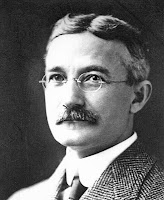 |
| Artist Ostner. J. H. Hawley photo. |
Born in Baden, Germany in 1828, Ostner emigrated to the U.S. around 1848-1850. Stories that pose him as an untutored natural genius are just that … stories. In reality, Charles received an early grounding in art at the University of Heidelberg and made a living as a sculptor, sketch artist, and photographer before coming to Idaho.
He settled first in California and began raising a family around 1852. Family members recalled that the artist had itchy feet, and often settled his wife and children someplace and then traveled extensively. Gold camps and other pioneer settlements held a deep fascination for him, yet there is no solid evidence that he prospected himself during these earlier years.
In 1862, gold excitement in Idaho attracted him to the Territory. By 1864, he had moved his family to the Garden Valley area. There, he had a small ranch and operated a toll bridge over the South Fork of the Payette River.
Historian Arthur Hart noted Ostner’s propensity for taking advantage of attention-grabbing events to sell his art, and the shoe seems to fit. H. T. French’s History presents the “untutored hobbyist” myth and what is almost certainly a fanciful tale about the George Washington statue. This major work supposedly grew out of deep-felt admiration for the “Father of our country.”
The story began with an almost mystical selection of the perfect yellow pine. The carving itself then required four years of winter nights – the only spare time he had – in freezing conditions, the only light provided by home-made tallow candles held in the trembling, crudely-wrapped fingers of his son. This fable even had a nice added touch: Ostner’s only model was the likeness of Washington printed on a postage stamp.
 |
| Ostner statue on the capitol grounds, Ostner’s wife - center - and two daughters at the base. J. H. Hawley photo. |
Charles finished the statue in 1868, then moved his family to Boise and “gave” the bronzed figure to the state. No doubt the inspiring story of this untutored genius, persevering through such terrible trials, got wide circulation. Some proposed a handsome award of $7 thousand, but the young Territory could only afford $2,500.
After that, Ostner used Boise as a home base for his wandering ways. Hawley’s History of Idaho said “Mr. Ostner continued to make Boise his home throughout his remaining days but traveled largely during that period, going on trips to various parts of the world."
One such trip was to Washington, D.C., where he unsuccessfully bid on memorial statues of General John Rawlins and Admiral David Farragut. His name doesn’t surface again until 1881, when he discussed his mining investments near Challis, Idaho.
Finally, a trip to the Nome, Alaska gold rush, when he was over 70 years old, was said to have cured his “wandering heel” and he stayed in Boise after about 1900.
His work included paintings on canvas, drawings, and a wide variety of lithographic masters. “Idaho’s Pioneer Artist,” passed away in 1913.
The statue stood on the capitol grounds until 1934 when it was moved indoors, refurbished, and covered in gold leaf. The figure still has a place in the Idaho capitol building.
| References: [French], [Hawley] |
| “[Bonanza Mine],” Weekly Miner, Butte; Idaho Statesman, Boise (April 6, 1880; October, 29, 1881).] |
| Arthur Hart, “Idaho History: Charles Ostner was an artist, miner and wanderer,” Idaho Statesman (July 4, 2010). |
| James H. Hawley, Eleventh Biennial Report of the Board of Trustees of the State Historical Society of Idaho, Boise (1928). |
| “[Statuary],” Philadelphia Inquirer, Philadelphia; National Republican, Washington (December 28, 1872; January 15, 1873). |













